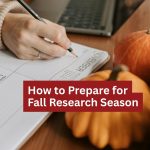It may feel like the holidays are far off and summer is still in full swing, but in the research world the clock is already ticking. Missing the planning window can mean delayed launches, missed shelf space, and lost sales opportunities. If you are preparing festive flavors, limited edition packaging, or seasonal product lines, August is the time to secure your sensory testing strategy. Use this checklist to keep your holiday research on track, deliver reliable results, and stay ahead of the seasonal rush.
Secure Your Fall Fieldwork First
Booking early avoids the last-minute scramble and ensures you have the right resources in place.
- Secure the right facility features
Choose facilities with the setup your study requires, such as controlled environments for consistent lighting, temperature, and sound, on-site kitchens for food preparation, and viewing options for clients to observe testing in real time.
- Be accessible to your audience
Select locations that are convenient for your target participants to reduce travel barriers and increase show rates. Strategic location choices improve participation and keep your timelines on track.
- Allow for refinement
Early bookings give you time for pilot testing, client feedback, and adjustments before your main testing window, ensuring the final execution runs smoothly.
Thinking about in-facility testing? Our research facilities in Toronto, Montreal, Vancouver, Edmonton, and other key markets are designed for more than just room rentals. Each location offers controlled environments, experienced on-site teams, and real-time client support. We also provide on-site translators who follow the moderator and participant dialogue, delivering real-time translation. From mall intercepts to sensory testing, every project is managed by dedicated local staff and a project manager who acts as an extension of your team. Clients can also observe sessions remotely from anywhere, making participation easy no matter where they are.
Related reading: Fieldwork That Works: What Every Researcher Needs to Plan for Fall Success explains how to navigate tight timelines and avoid common fall research challenges.
Match the Method to the Moment
Selecting the right method ensures your sensory testing produces authentic and actionable results.
- Central Location Tests (CLTs)
Best for controlled evaluations where every participant experiences the product under identical conditions. Our spaces are equipped for taste, scent, and texture testing with real-time observation capabilities.
- In-Home Usage Tests (IHUTs)
Ideal for products that need to be tested in everyday settings. We manage all logistics for perishable, frozen, or fragile items, from packaging to temperature-controlled shipping, so products arrive in perfect condition for evaluation.
To test a new feature or upgrades, you can use IN-HOME USAGE TESTS (IHUTs) and in-person product testing. These approaches are designed to evaluate consumer preferences regarding your new features or packaging options.
If you’re getting ready to run an IHUTs using panel data, now’s a great time to download our Plain Language Guide to Product and Package Tests
- Post-trial follow ups
Conduct online surveys or interviews to capture feedback, including purchase intent and real-life product impressions.
Related reading: Seasonal Strategies: Engaging Your Audience and Gathering Data Through On-Site Activations shows how immersive experiences can enhance feedback quality.
Keep It Real and Compliant
Ethical, inclusive, and compliant practices are essential to credible sensory testing. From verifying who participates to ensuring accessibility and privacy, every step must protect the integrity of your results and the comfort of your respondents.
- Recruit the right participants
Whether targeting low-incidence groups, medical professionals, bilingual households, or general consumers, success comes from working with genuine participants rather than filling quotas. We verify participant identities, recruit from vetted sources, and pay panelists by cheque to confirm both identity and Canadian address.
- Follow age appropriate and privacy protocols
Always secure parental consent when testing with minors and ensure your study complies with privacy laws when collecting personal information or offering incentives.
- Design with accessibility in mind
Create surveys and packaging that meet WCAG 2.1 standards and AODA guidelines so participants of all abilities can take part comfortably. This includes screen reader compatibility, clear fonts, and easy-to-use questionnaire layouts.
Related reading: Inclusive Survey Design – Best Practices for Demographic Questions offers practical advice on building inclusive surveys that improve participant comfort and representation.
Optimize for Speed Without Sacrificing Quality
The holiday season moves quickly, and unexpected delays or challenges are more common than many realize. From postal strikes and cross-border shipping slowdowns to last-minute regulation changes and packaging failures, thoughtful preparation always outperforms a rushed launch. The aim is to move quickly enough to meet deadlines while maintaining the accuracy and reliability your decisions require.
- Use modular study designs
Structure your study in smaller phases so you can deliver early topline results while full data collection continues. This allows stakeholders to make timely decisions without waiting for the entire project to finish.
- Work with an end to end provider
Partner with a team that can manage recruitment, programming, hosting, logistics, and sensory operations under one roof. This reduces handoffs, shortens timelines, and improves accountability.
- Run a pilot before launch
A small-scale trial can reveal programming issues, unclear instructions, or stimulus delivery problems before they become costly at full scale.
Related reading: 5 Essential Practices to Ensure High-Quality Online Sample for Your Research explains how to protect data quality while working within tight schedules.
Turn Results Into Holiday Strategy
Sensory testing should not end when the data is collected. The findings are an opportunity to refine and strengthen your holiday market approach.
- De risk innovation and guide execution
Use real consumer feedback to validate new flavors, packaging, or messaging before committing to full production.
- Align product insights with market strategy
Apply sensory results to influence marketing campaigns, retail placement, and seasonal storytelling that resonates with consumers.
- Build a foundation for next year
Incorporate lessons learned into your innovation process to improve timing, targeting, and performance for future seasonal launches.
Related reading: From Risk to Revenue: How Consumer Research Turns Innovation Into Growth highlights how research drives better decision-making and reduces commercial risk.
Ready to get started? Let’s discuss how our team can make your next holiday launch seamless, on time, and backed by reliable data you can trust.




